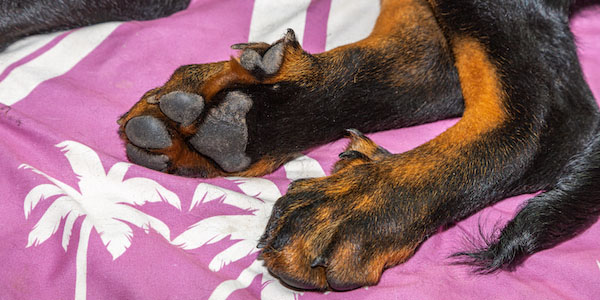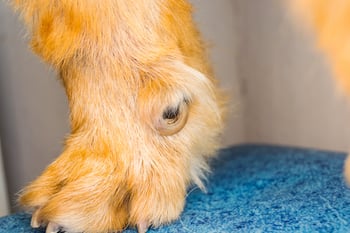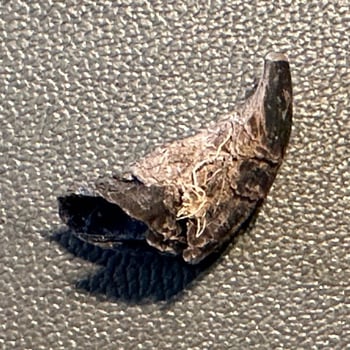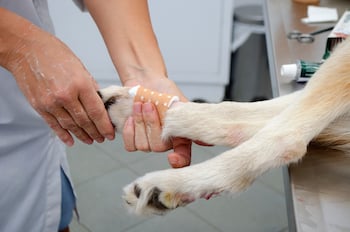 What Are Dewclaws?
What Are Dewclaws?
A dog’s front dewclaw is often equated to a human’s thumb. While the dewclaw does not offer all the same benefits as the human thumb — it's not opposable! — it still has an important purpose.
The front dewclaw has five tendons attached to it and plays a significant role when dogs are in motion.
It helps a dog grip and manipulate items they are chewing on and helps some dogs get out of water.
The dewclaw helps stabilize the carpus (the wrist) of the lead leg by touching the ground when a dog is in a gallop or canter. The dewclaw digs into the ground providing support to the limb when dogs turn. For this reason, dogs who compete in agility or other dog sports can benefit from having front dewclaws.
Rear dewclaws are rare, typically seen in only certain breeds, and do not seem to serve any function. In some breeds, there are even double rear dewclaws! Rear dewclaws are often only attached to the body by the skin.
Do All Dogs Have Dewclaws?
Most dogs have front dewclaws. If you don't see a dewclaw on your dog's front paws, it was likely removed. Many hunting breeds have their dewclaws removed to prevent them from being caught and injured while running through brush and tough terrain.
Rear dewclaws, like front dewclaws, are genetic. They are typically seen in breeds such as the Great Pyrenees, St. Bernard, Icelandic Sheepdogs, Briard, and a few others.
There are certain breeds of dogs where it has become customary to show them with the front dewclaws removed. However, there are breeds where dewclaws are a part of the breed standard and are required in the show ring.
The Norwegian Lundehund, a rare Spitz breed, has SIX toes on all four feet. These extra claws helped them climb rocky ledges in their historical job of hunting Puffin birds.
Another example is the Great Pyrenees, which is expected to have a dewclaw on each front leg and double dewclaws on each rear leg.
 Trimming Your Dog's Dewclaws
Trimming Your Dog's Dewclaws
If your dog has either front or rear dewclaws, it's important not to forget about trimming them just like you do their regular nails.
Dewclaws can easily become overgrown, making them more at risk of getting caught and injured or growing back painfully into the dewclaw pad or a dog's leg. Be sure to trim your dog's dewclaws regularly.
 Dewclaw Falls Off!
Dewclaw Falls Off!
There are cases where you may find a dewclaw or another nail on the floor (like the dewclaw in the photo). This actually isn't the whole nail.
This can happen when dirt and fur get caught around the nail creating a ‘solid cover,’ and it pulls off the outer layer. Similar to when our nails break and peel.
This can happen when your dog is licking or chewing at the nail or if it gets snagged on something.
Note: Older pets tend to have drier nails, and they tend to be more brittle and break more easily. Therefore, it is especially important to trim older dogs’ nails regularly. When nails are extremely brittle, it is called onychorrhexis.
Anytime your dog is licking, biting, or chewing on their nails, be sure to inspect their nails, nailbed, and paw closely. This is typically an indicator that something isn’t right. Read more about nail health and trimming.
When Are Dewclaws Removed?
Typically, dewclaws are removed by a breeder (or the breeder's veterinarian) at three to five days of age. When done at home, they are clipped off with scissors or nail clippers.
If done by a veterinarian, they are removed under local anesthesia, clamps, and a scalpel. It is possible when dewclaw removal is done at this age that, there can be regrowth of the nail.
This is why it's best to have this procedure done by a veterinarian, as they will remove all the bones so that nothing grows back.
After this early age, dewclaws must be removed by a veterinarian when the dog is sedated, as it is considered an amputation. In some cases, this is done at the same time as spay or neuter surgeries.
Is Removing Dewclaws Cruel?
Front dewclaw removal is often regarded as an unnecessary procedure. It is not recommended to remove dewclaws unless there is a medical reason to do so, such as severe injury (a partially torn-off dewclaw) or disease (i.e., cancer).
This process is done under general anesthesia and requires pain meds, bandage changes, activity restriction, and wearing a cone post-op. There is always a risk of infection and scarring at the removed dewclaw site. In some cases, regrowth of the nail is possible.
Removal of front dewclaws can potentially cause issues later in life. Without a front dewclaw, there seems to be a higher likelihood that the carpal (wrist) ligaments can stretch and tear. When this occurs, there is a risk of laxity and arthritis as time progresses.
Additionally, this can create more stress on other joints of the leg and spine to compensate for the weakness in the carpus region. Removing a dog's dewclaws is a personal choice among breeders, owners, and veterinarians.

Should rear dewclaws be removed?
Often, rear dewclaw removal is recommended when they are only attached by the skin and have a tendency to dangle.
Removal in these situations does appear to help prevent injuries because they can’t get caught on things. It can also help prevent ingrown dewclaw nails.
This is often done at the time the dog is spayed or neutered since the dog will already be under general anesthesia and be on pain medications following the procedure.
How long does it take for dewclaw removal to heal?
After a dog's dewclaws are removed, the healing and recovery process usually takes up to two weeks. If done at a few days old, the wound should heal in three days, with no sutures needing removal. If removed by a veterinarian and sutured closed, the vet will remove the sutures between 10 to 14 days after the procedure.
Daily bandage changes are required for both front and rear dewclaw removal, and infection is always possible. Learn how to care for your dog's wound to help them heal properly.
Watch for signs of pain or discomfort, such as limping, constantly trying to lick or bite the area, and touch avoidance. Monitor for swelling and bleeding, and contact your veterinarian if you're worried about how the removal site is healing.




